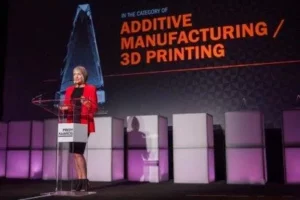 Potomac was honored when SPIE, a premier laser and photonics technical society, invited us to present the Prism Award recently at Photonics West. Co-sponsored by Photonics Media, the Prism Award recognizes advances in photonics innovation for areas such as 3D Printing, industrial lasers, biomedical instrumentation and sensors.
Potomac was honored when SPIE, a premier laser and photonics technical society, invited us to present the Prism Award recently at Photonics West. Co-sponsored by Photonics Media, the Prism Award recognizes advances in photonics innovation for areas such as 3D Printing, industrial lasers, biomedical instrumentation and sensors.
But for us the award reiterated the strong innovation legacy in the photonics industry. You see, Potomac won the predecessor to the Prism award in 1990 for our initial product, the ultraviolet waveguide laser.

Although many changes have occurred in the industry over these many years, the one thing that has not changed is the thirst for developing new technologies that lead to products, enabling future applications in a wide variety of fields. At Potomac, our founder, Dr. Paul Christensen invented an ultraviolet laser with which we pushed the boundaries of laser micromachining. Through process development in partnership with our customers in the medical device, biotech, and microelectronics industries, we were able to expand the knowledge base and develop the laser micromachining expertise for which we are known today.
 Not one to rest on our past successes, our current President and CEO, Mike Adelstein, took Potomac from a laser micromachining company to an advanced manufacturing supplier. Combining our core competency in optics and lasers with new technologies like Micro-CNC, hot embossing and 3D printing, Potomac now provides complete solutions to customers in emerging fields such as microfluidics, solar energy, personalized medicine and robotics.
Not one to rest on our past successes, our current President and CEO, Mike Adelstein, took Potomac from a laser micromachining company to an advanced manufacturing supplier. Combining our core competency in optics and lasers with new technologies like Micro-CNC, hot embossing and 3D printing, Potomac now provides complete solutions to customers in emerging fields such as microfluidics, solar energy, personalized medicine and robotics.

Lasers and photonics have been the basis of many innovations in industry and manufacturing. The first 3D printers were laser-based stereolithography machines and metal additive manufacturing tools also use lasers to build up parts from powders. For the Prism Awards Potomac was tapped to present the 3D Printing award, the winner of which was PolarOnyx, whose machine uses femtosecond fiber lasers to 3D Print tungsten parts, a great example of laser innovation.
While it is never certain what the future holds for Potomac, advanced manufacturing and the laser industry, we do know that innovation will continue for years to come!


